An Analysis of IMO Strategic Directions in the Shipping Industry
VerifiedAdded on 2023/05/27
|10
|2597
|208
Report
AI Summary
This report examines the International Maritime Organization (IMO) and its strategic directions within the shipping industry. It begins with an introduction to the IMO, its formation, and its role as a regulatory body. The report then delves into MARPOL 73/78, detailing the convention's significance in preventing pollution from ships and the various annexes addressing different types of pollution. It explores the IMO's role in developing regulatory frameworks, including the committees and sub-committees involved in maritime safety, environmental protection, and technical cooperation. Furthermore, the report focuses on the IMO's contribution to the development of environmental emission rules related to MARPOL Annex VI, highlighting the efforts to reduce carbon footprints and limit emissions. It also discusses the issues and challenges faced by the IMO in implementing these regulations, such as the application of rules to various ship operations and the need for effective monitoring and enforcement. The report concludes by emphasizing the importance of the IMO's ongoing efforts to monitor and reduce water and air pollution, ensuring the safety and sustainability of the shipping industry.
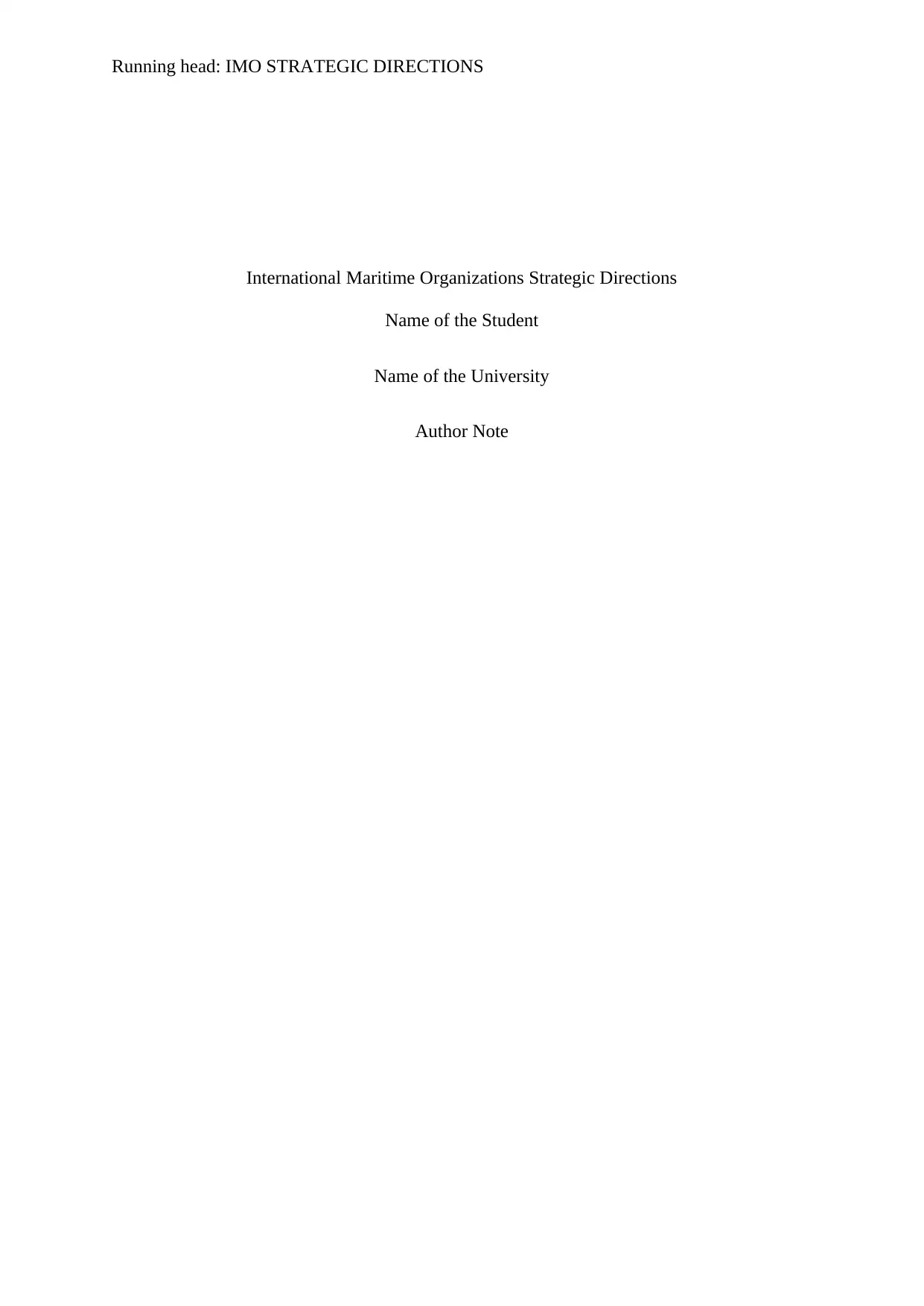
Running head: IMO STRATEGIC DIRECTIONS
International Maritime Organizations Strategic Directions
Name of the Student
Name of the University
Author Note
International Maritime Organizations Strategic Directions
Name of the Student
Name of the University
Author Note
Secure Best Marks with AI Grader
Need help grading? Try our AI Grader for instant feedback on your assignments.
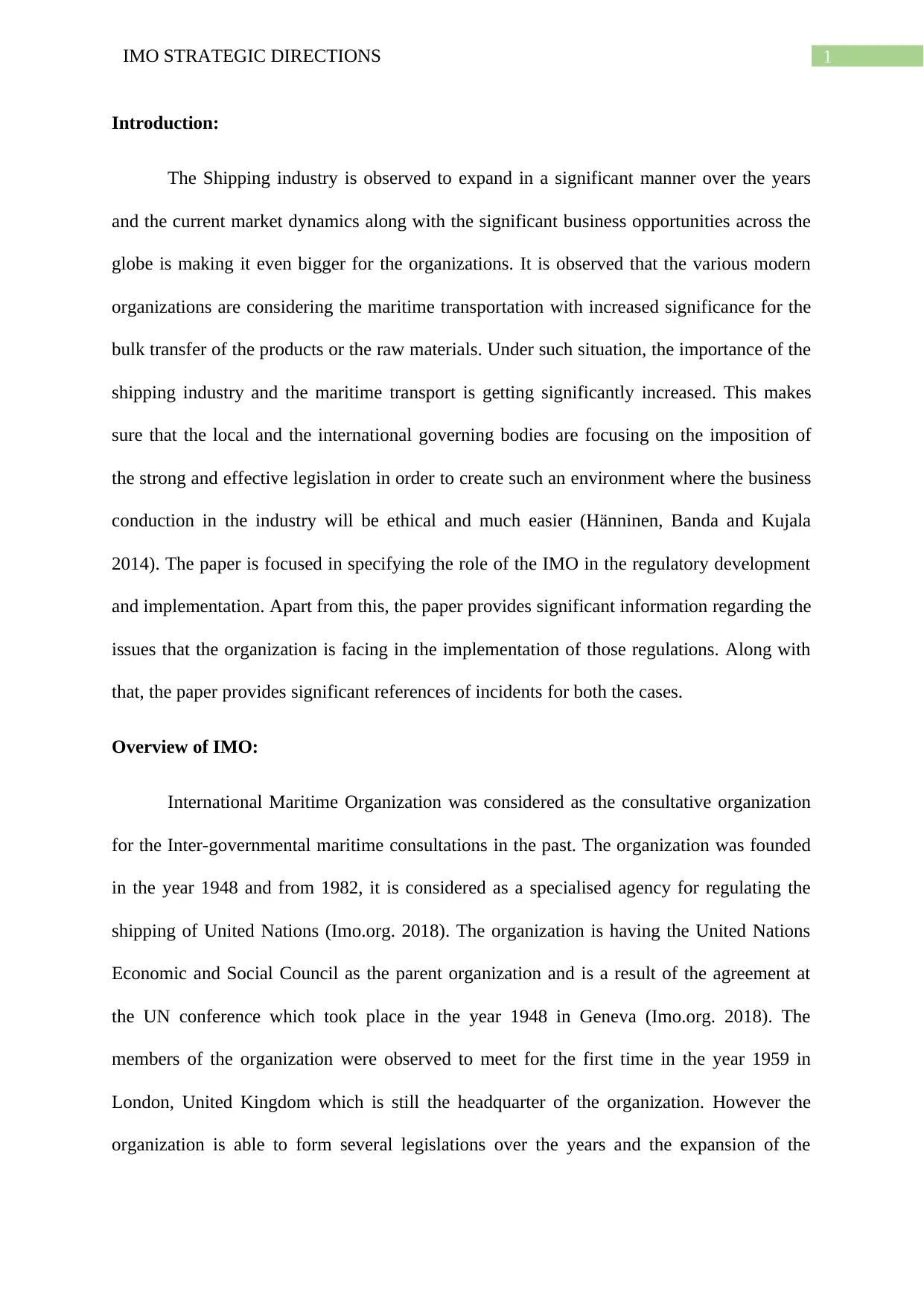
1IMO STRATEGIC DIRECTIONS
Introduction:
The Shipping industry is observed to expand in a significant manner over the years
and the current market dynamics along with the significant business opportunities across the
globe is making it even bigger for the organizations. It is observed that the various modern
organizations are considering the maritime transportation with increased significance for the
bulk transfer of the products or the raw materials. Under such situation, the importance of the
shipping industry and the maritime transport is getting significantly increased. This makes
sure that the local and the international governing bodies are focusing on the imposition of
the strong and effective legislation in order to create such an environment where the business
conduction in the industry will be ethical and much easier (Hänninen, Banda and Kujala
2014). The paper is focused in specifying the role of the IMO in the regulatory development
and implementation. Apart from this, the paper provides significant information regarding the
issues that the organization is facing in the implementation of those regulations. Along with
that, the paper provides significant references of incidents for both the cases.
Overview of IMO:
International Maritime Organization was considered as the consultative organization
for the Inter-governmental maritime consultations in the past. The organization was founded
in the year 1948 and from 1982, it is considered as a specialised agency for regulating the
shipping of United Nations (Imo.org. 2018). The organization is having the United Nations
Economic and Social Council as the parent organization and is a result of the agreement at
the UN conference which took place in the year 1948 in Geneva (Imo.org. 2018). The
members of the organization were observed to meet for the first time in the year 1959 in
London, United Kingdom which is still the headquarter of the organization. However the
organization is able to form several legislations over the years and the expansion of the
Introduction:
The Shipping industry is observed to expand in a significant manner over the years
and the current market dynamics along with the significant business opportunities across the
globe is making it even bigger for the organizations. It is observed that the various modern
organizations are considering the maritime transportation with increased significance for the
bulk transfer of the products or the raw materials. Under such situation, the importance of the
shipping industry and the maritime transport is getting significantly increased. This makes
sure that the local and the international governing bodies are focusing on the imposition of
the strong and effective legislation in order to create such an environment where the business
conduction in the industry will be ethical and much easier (Hänninen, Banda and Kujala
2014). The paper is focused in specifying the role of the IMO in the regulatory development
and implementation. Apart from this, the paper provides significant information regarding the
issues that the organization is facing in the implementation of those regulations. Along with
that, the paper provides significant references of incidents for both the cases.
Overview of IMO:
International Maritime Organization was considered as the consultative organization
for the Inter-governmental maritime consultations in the past. The organization was founded
in the year 1948 and from 1982, it is considered as a specialised agency for regulating the
shipping of United Nations (Imo.org. 2018). The organization is having the United Nations
Economic and Social Council as the parent organization and is a result of the agreement at
the UN conference which took place in the year 1948 in Geneva (Imo.org. 2018). The
members of the organization were observed to meet for the first time in the year 1959 in
London, United Kingdom which is still the headquarter of the organization. However the
organization is able to form several legislations over the years and the expansion of the
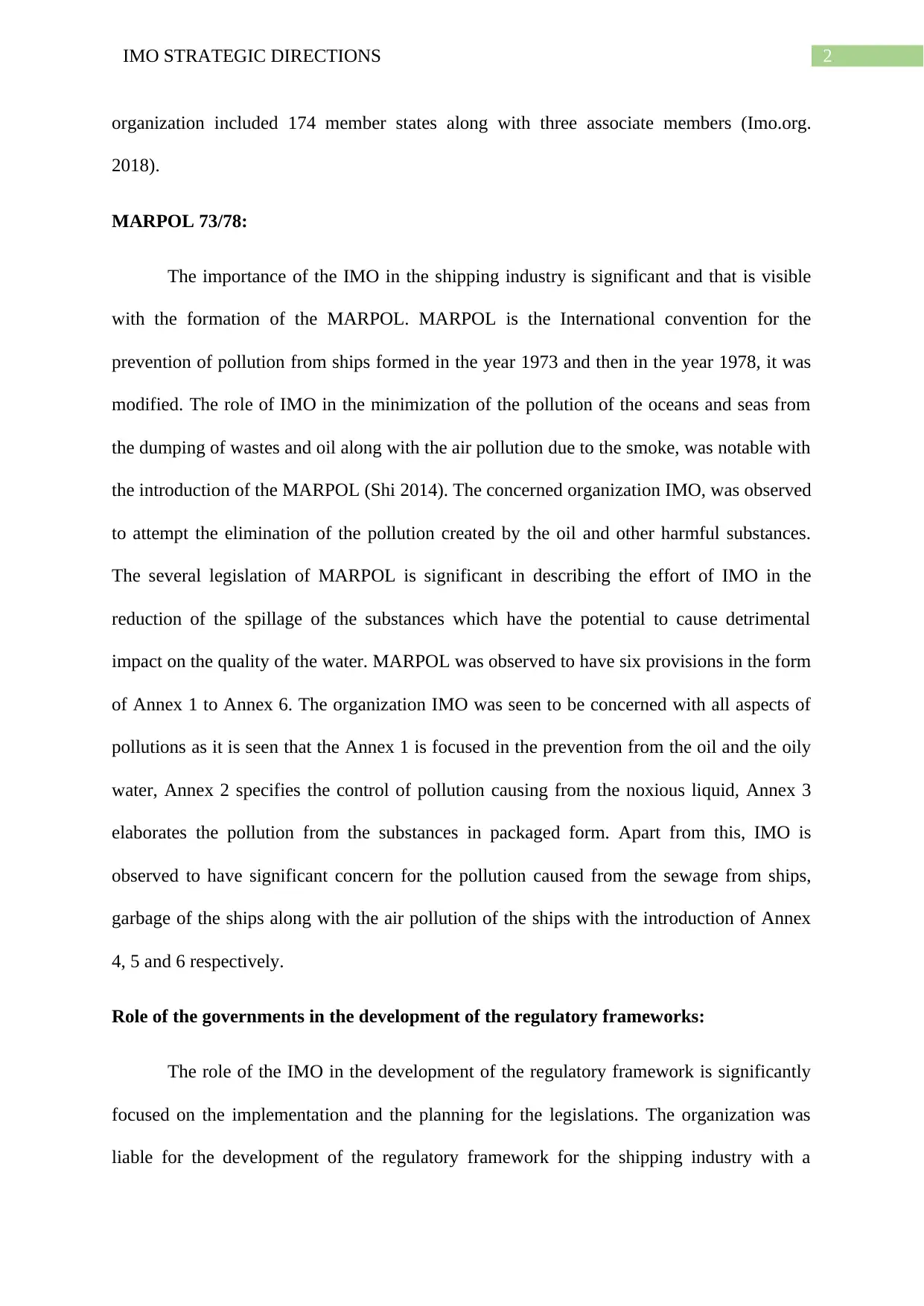
2IMO STRATEGIC DIRECTIONS
organization included 174 member states along with three associate members (Imo.org.
2018).
MARPOL 73/78:
The importance of the IMO in the shipping industry is significant and that is visible
with the formation of the MARPOL. MARPOL is the International convention for the
prevention of pollution from ships formed in the year 1973 and then in the year 1978, it was
modified. The role of IMO in the minimization of the pollution of the oceans and seas from
the dumping of wastes and oil along with the air pollution due to the smoke, was notable with
the introduction of the MARPOL (Shi 2014). The concerned organization IMO, was observed
to attempt the elimination of the pollution created by the oil and other harmful substances.
The several legislation of MARPOL is significant in describing the effort of IMO in the
reduction of the spillage of the substances which have the potential to cause detrimental
impact on the quality of the water. MARPOL was observed to have six provisions in the form
of Annex 1 to Annex 6. The organization IMO was seen to be concerned with all aspects of
pollutions as it is seen that the Annex 1 is focused in the prevention from the oil and the oily
water, Annex 2 specifies the control of pollution causing from the noxious liquid, Annex 3
elaborates the pollution from the substances in packaged form. Apart from this, IMO is
observed to have significant concern for the pollution caused from the sewage from ships,
garbage of the ships along with the air pollution of the ships with the introduction of Annex
4, 5 and 6 respectively.
Role of the governments in the development of the regulatory frameworks:
The role of the IMO in the development of the regulatory framework is significantly
focused on the implementation and the planning for the legislations. The organization was
liable for the development of the regulatory framework for the shipping industry with a
organization included 174 member states along with three associate members (Imo.org.
2018).
MARPOL 73/78:
The importance of the IMO in the shipping industry is significant and that is visible
with the formation of the MARPOL. MARPOL is the International convention for the
prevention of pollution from ships formed in the year 1973 and then in the year 1978, it was
modified. The role of IMO in the minimization of the pollution of the oceans and seas from
the dumping of wastes and oil along with the air pollution due to the smoke, was notable with
the introduction of the MARPOL (Shi 2014). The concerned organization IMO, was observed
to attempt the elimination of the pollution created by the oil and other harmful substances.
The several legislation of MARPOL is significant in describing the effort of IMO in the
reduction of the spillage of the substances which have the potential to cause detrimental
impact on the quality of the water. MARPOL was observed to have six provisions in the form
of Annex 1 to Annex 6. The organization IMO was seen to be concerned with all aspects of
pollutions as it is seen that the Annex 1 is focused in the prevention from the oil and the oily
water, Annex 2 specifies the control of pollution causing from the noxious liquid, Annex 3
elaborates the pollution from the substances in packaged form. Apart from this, IMO is
observed to have significant concern for the pollution caused from the sewage from ships,
garbage of the ships along with the air pollution of the ships with the introduction of Annex
4, 5 and 6 respectively.
Role of the governments in the development of the regulatory frameworks:
The role of the IMO in the development of the regulatory framework is significantly
focused on the implementation and the planning for the legislations. The organization was
liable for the development of the regulatory framework for the shipping industry with a
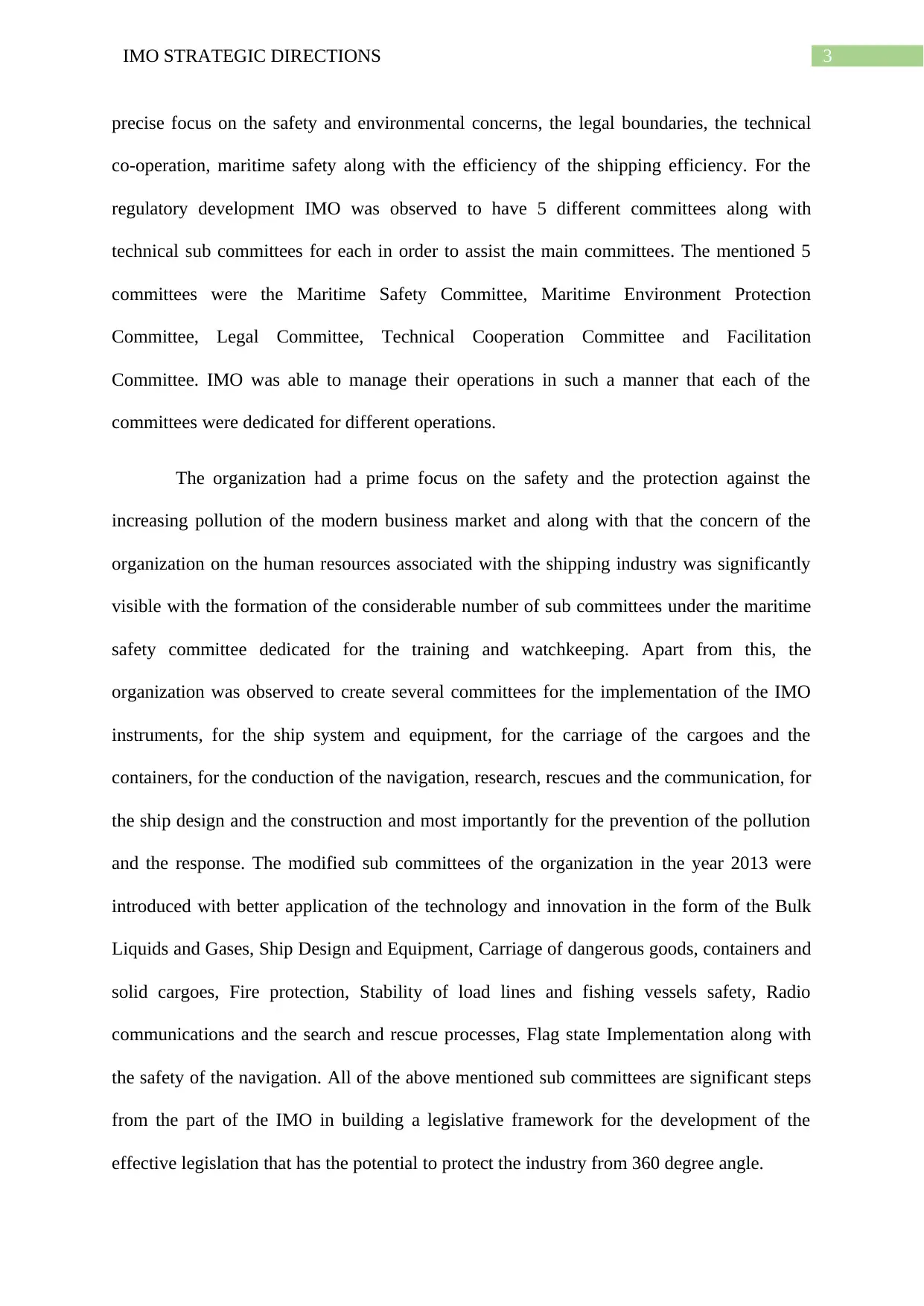
3IMO STRATEGIC DIRECTIONS
precise focus on the safety and environmental concerns, the legal boundaries, the technical
co-operation, maritime safety along with the efficiency of the shipping efficiency. For the
regulatory development IMO was observed to have 5 different committees along with
technical sub committees for each in order to assist the main committees. The mentioned 5
committees were the Maritime Safety Committee, Maritime Environment Protection
Committee, Legal Committee, Technical Cooperation Committee and Facilitation
Committee. IMO was able to manage their operations in such a manner that each of the
committees were dedicated for different operations.
The organization had a prime focus on the safety and the protection against the
increasing pollution of the modern business market and along with that the concern of the
organization on the human resources associated with the shipping industry was significantly
visible with the formation of the considerable number of sub committees under the maritime
safety committee dedicated for the training and watchkeeping. Apart from this, the
organization was observed to create several committees for the implementation of the IMO
instruments, for the ship system and equipment, for the carriage of the cargoes and the
containers, for the conduction of the navigation, research, rescues and the communication, for
the ship design and the construction and most importantly for the prevention of the pollution
and the response. The modified sub committees of the organization in the year 2013 were
introduced with better application of the technology and innovation in the form of the Bulk
Liquids and Gases, Ship Design and Equipment, Carriage of dangerous goods, containers and
solid cargoes, Fire protection, Stability of load lines and fishing vessels safety, Radio
communications and the search and rescue processes, Flag state Implementation along with
the safety of the navigation. All of the above mentioned sub committees are significant steps
from the part of the IMO in building a legislative framework for the development of the
effective legislation that has the potential to protect the industry from 360 degree angle.
precise focus on the safety and environmental concerns, the legal boundaries, the technical
co-operation, maritime safety along with the efficiency of the shipping efficiency. For the
regulatory development IMO was observed to have 5 different committees along with
technical sub committees for each in order to assist the main committees. The mentioned 5
committees were the Maritime Safety Committee, Maritime Environment Protection
Committee, Legal Committee, Technical Cooperation Committee and Facilitation
Committee. IMO was able to manage their operations in such a manner that each of the
committees were dedicated for different operations.
The organization had a prime focus on the safety and the protection against the
increasing pollution of the modern business market and along with that the concern of the
organization on the human resources associated with the shipping industry was significantly
visible with the formation of the considerable number of sub committees under the maritime
safety committee dedicated for the training and watchkeeping. Apart from this, the
organization was observed to create several committees for the implementation of the IMO
instruments, for the ship system and equipment, for the carriage of the cargoes and the
containers, for the conduction of the navigation, research, rescues and the communication, for
the ship design and the construction and most importantly for the prevention of the pollution
and the response. The modified sub committees of the organization in the year 2013 were
introduced with better application of the technology and innovation in the form of the Bulk
Liquids and Gases, Ship Design and Equipment, Carriage of dangerous goods, containers and
solid cargoes, Fire protection, Stability of load lines and fishing vessels safety, Radio
communications and the search and rescue processes, Flag state Implementation along with
the safety of the navigation. All of the above mentioned sub committees are significant steps
from the part of the IMO in building a legislative framework for the development of the
effective legislation that has the potential to protect the industry from 360 degree angle.
Secure Best Marks with AI Grader
Need help grading? Try our AI Grader for instant feedback on your assignments.
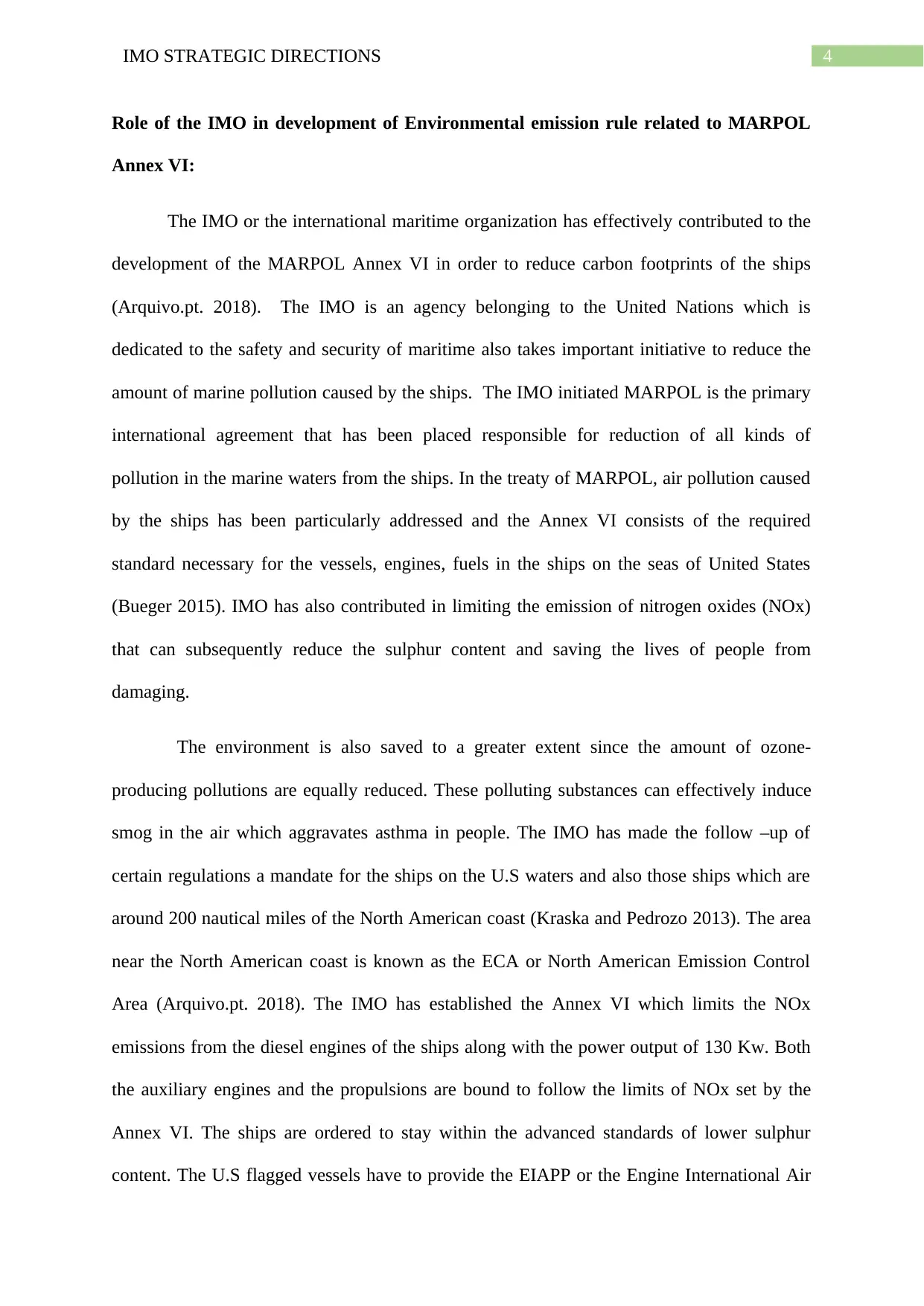
4IMO STRATEGIC DIRECTIONS
Role of the IMO in development of Environmental emission rule related to MARPOL
Annex VI:
The IMO or the international maritime organization has effectively contributed to the
development of the MARPOL Annex VI in order to reduce carbon footprints of the ships
(Arquivo.pt. 2018). The IMO is an agency belonging to the United Nations which is
dedicated to the safety and security of maritime also takes important initiative to reduce the
amount of marine pollution caused by the ships. The IMO initiated MARPOL is the primary
international agreement that has been placed responsible for reduction of all kinds of
pollution in the marine waters from the ships. In the treaty of MARPOL, air pollution caused
by the ships has been particularly addressed and the Annex VI consists of the required
standard necessary for the vessels, engines, fuels in the ships on the seas of United States
(Bueger 2015). IMO has also contributed in limiting the emission of nitrogen oxides (NOx)
that can subsequently reduce the sulphur content and saving the lives of people from
damaging.
The environment is also saved to a greater extent since the amount of ozone-
producing pollutions are equally reduced. These polluting substances can effectively induce
smog in the air which aggravates asthma in people. The IMO has made the follow –up of
certain regulations a mandate for the ships on the U.S waters and also those ships which are
around 200 nautical miles of the North American coast (Kraska and Pedrozo 2013). The area
near the North American coast is known as the ECA or North American Emission Control
Area (Arquivo.pt. 2018). The IMO has established the Annex VI which limits the NOx
emissions from the diesel engines of the ships along with the power output of 130 Kw. Both
the auxiliary engines and the propulsions are bound to follow the limits of NOx set by the
Annex VI. The ships are ordered to stay within the advanced standards of lower sulphur
content. The U.S flagged vessels have to provide the EIAPP or the Engine International Air
Role of the IMO in development of Environmental emission rule related to MARPOL
Annex VI:
The IMO or the international maritime organization has effectively contributed to the
development of the MARPOL Annex VI in order to reduce carbon footprints of the ships
(Arquivo.pt. 2018). The IMO is an agency belonging to the United Nations which is
dedicated to the safety and security of maritime also takes important initiative to reduce the
amount of marine pollution caused by the ships. The IMO initiated MARPOL is the primary
international agreement that has been placed responsible for reduction of all kinds of
pollution in the marine waters from the ships. In the treaty of MARPOL, air pollution caused
by the ships has been particularly addressed and the Annex VI consists of the required
standard necessary for the vessels, engines, fuels in the ships on the seas of United States
(Bueger 2015). IMO has also contributed in limiting the emission of nitrogen oxides (NOx)
that can subsequently reduce the sulphur content and saving the lives of people from
damaging.
The environment is also saved to a greater extent since the amount of ozone-
producing pollutions are equally reduced. These polluting substances can effectively induce
smog in the air which aggravates asthma in people. The IMO has made the follow –up of
certain regulations a mandate for the ships on the U.S waters and also those ships which are
around 200 nautical miles of the North American coast (Kraska and Pedrozo 2013). The area
near the North American coast is known as the ECA or North American Emission Control
Area (Arquivo.pt. 2018). The IMO has established the Annex VI which limits the NOx
emissions from the diesel engines of the ships along with the power output of 130 Kw. Both
the auxiliary engines and the propulsions are bound to follow the limits of NOx set by the
Annex VI. The ships are ordered to stay within the advanced standards of lower sulphur
content. The U.S flagged vessels have to provide the EIAPP or the Engine International Air
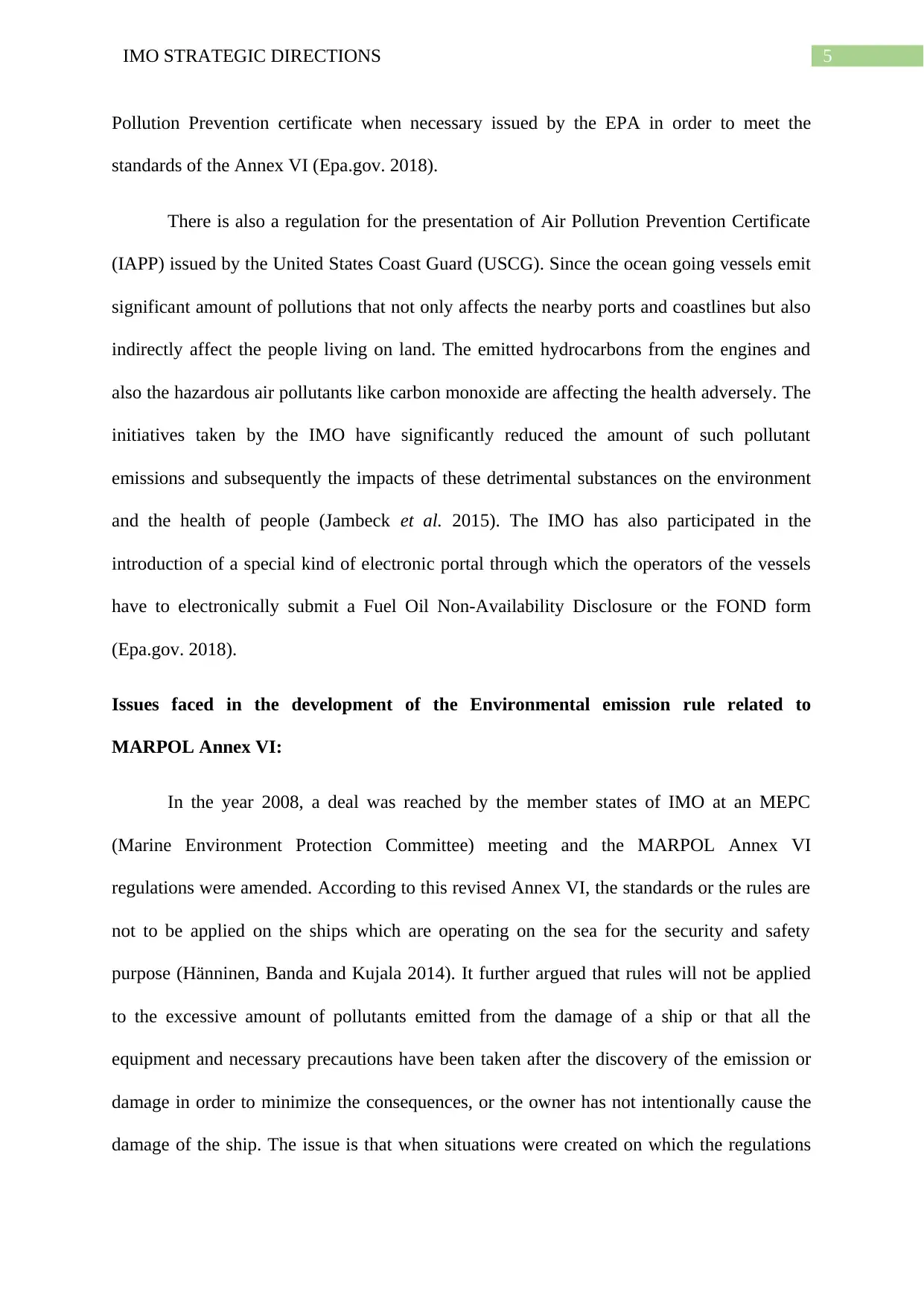
5IMO STRATEGIC DIRECTIONS
Pollution Prevention certificate when necessary issued by the EPA in order to meet the
standards of the Annex VI (Epa.gov. 2018).
There is also a regulation for the presentation of Air Pollution Prevention Certificate
(IAPP) issued by the United States Coast Guard (USCG). Since the ocean going vessels emit
significant amount of pollutions that not only affects the nearby ports and coastlines but also
indirectly affect the people living on land. The emitted hydrocarbons from the engines and
also the hazardous air pollutants like carbon monoxide are affecting the health adversely. The
initiatives taken by the IMO have significantly reduced the amount of such pollutant
emissions and subsequently the impacts of these detrimental substances on the environment
and the health of people (Jambeck et al. 2015). The IMO has also participated in the
introduction of a special kind of electronic portal through which the operators of the vessels
have to electronically submit a Fuel Oil Non-Availability Disclosure or the FOND form
(Epa.gov. 2018).
Issues faced in the development of the Environmental emission rule related to
MARPOL Annex VI:
In the year 2008, a deal was reached by the member states of IMO at an MEPC
(Marine Environment Protection Committee) meeting and the MARPOL Annex VI
regulations were amended. According to this revised Annex VI, the standards or the rules are
not to be applied on the ships which are operating on the sea for the security and safety
purpose (Hänninen, Banda and Kujala 2014). It further argued that rules will not be applied
to the excessive amount of pollutants emitted from the damage of a ship or that all the
equipment and necessary precautions have been taken after the discovery of the emission or
damage in order to minimize the consequences, or the owner has not intentionally cause the
damage of the ship. The issue is that when situations were created on which the regulations
Pollution Prevention certificate when necessary issued by the EPA in order to meet the
standards of the Annex VI (Epa.gov. 2018).
There is also a regulation for the presentation of Air Pollution Prevention Certificate
(IAPP) issued by the United States Coast Guard (USCG). Since the ocean going vessels emit
significant amount of pollutions that not only affects the nearby ports and coastlines but also
indirectly affect the people living on land. The emitted hydrocarbons from the engines and
also the hazardous air pollutants like carbon monoxide are affecting the health adversely. The
initiatives taken by the IMO have significantly reduced the amount of such pollutant
emissions and subsequently the impacts of these detrimental substances on the environment
and the health of people (Jambeck et al. 2015). The IMO has also participated in the
introduction of a special kind of electronic portal through which the operators of the vessels
have to electronically submit a Fuel Oil Non-Availability Disclosure or the FOND form
(Epa.gov. 2018).
Issues faced in the development of the Environmental emission rule related to
MARPOL Annex VI:
In the year 2008, a deal was reached by the member states of IMO at an MEPC
(Marine Environment Protection Committee) meeting and the MARPOL Annex VI
regulations were amended. According to this revised Annex VI, the standards or the rules are
not to be applied on the ships which are operating on the sea for the security and safety
purpose (Hänninen, Banda and Kujala 2014). It further argued that rules will not be applied
to the excessive amount of pollutants emitted from the damage of a ship or that all the
equipment and necessary precautions have been taken after the discovery of the emission or
damage in order to minimize the consequences, or the owner has not intentionally cause the
damage of the ship. The issue is that when situations were created on which the regulations
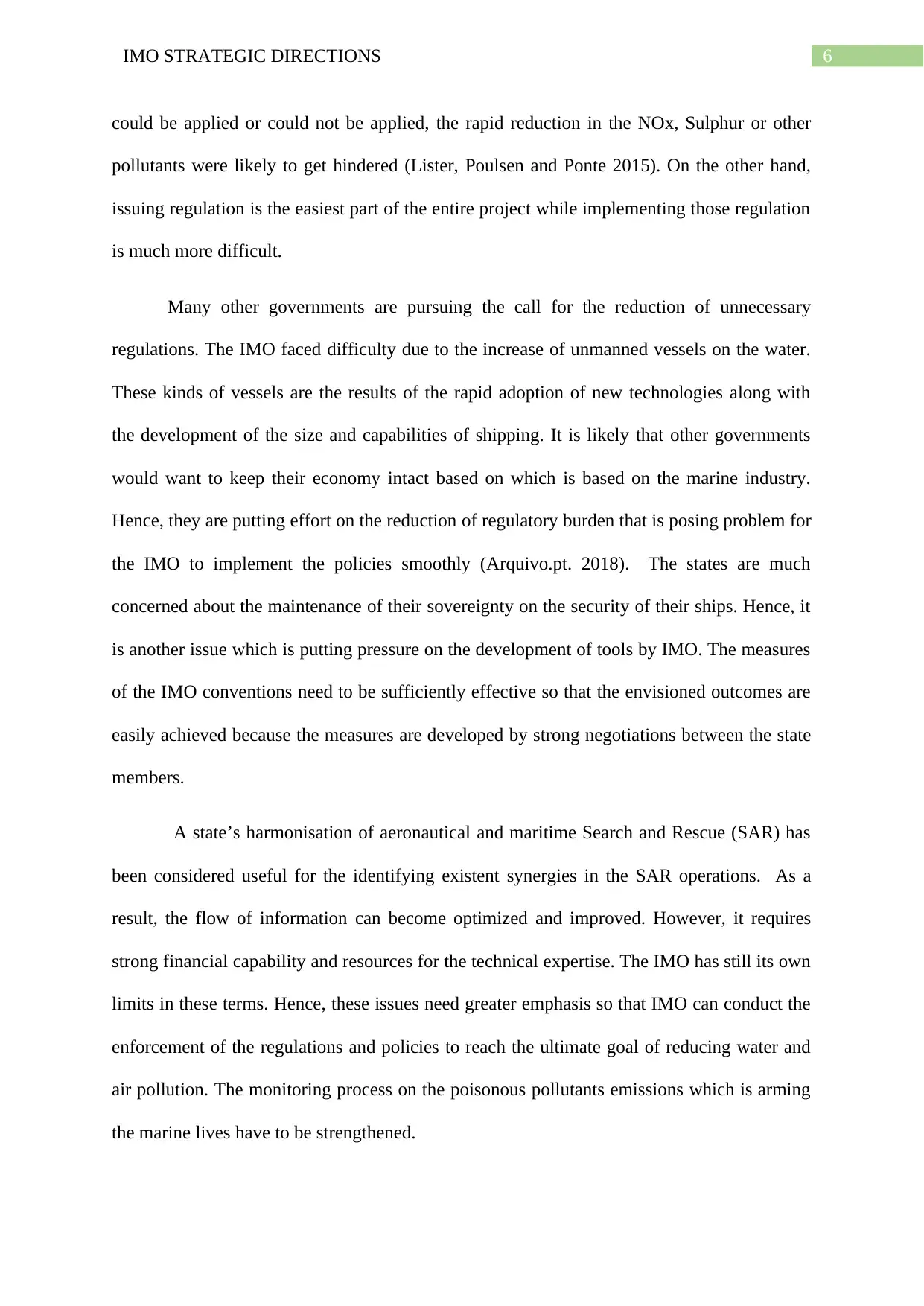
6IMO STRATEGIC DIRECTIONS
could be applied or could not be applied, the rapid reduction in the NOx, Sulphur or other
pollutants were likely to get hindered (Lister, Poulsen and Ponte 2015). On the other hand,
issuing regulation is the easiest part of the entire project while implementing those regulation
is much more difficult.
Many other governments are pursuing the call for the reduction of unnecessary
regulations. The IMO faced difficulty due to the increase of unmanned vessels on the water.
These kinds of vessels are the results of the rapid adoption of new technologies along with
the development of the size and capabilities of shipping. It is likely that other governments
would want to keep their economy intact based on which is based on the marine industry.
Hence, they are putting effort on the reduction of regulatory burden that is posing problem for
the IMO to implement the policies smoothly (Arquivo.pt. 2018). The states are much
concerned about the maintenance of their sovereignty on the security of their ships. Hence, it
is another issue which is putting pressure on the development of tools by IMO. The measures
of the IMO conventions need to be sufficiently effective so that the envisioned outcomes are
easily achieved because the measures are developed by strong negotiations between the state
members.
A state’s harmonisation of aeronautical and maritime Search and Rescue (SAR) has
been considered useful for the identifying existent synergies in the SAR operations. As a
result, the flow of information can become optimized and improved. However, it requires
strong financial capability and resources for the technical expertise. The IMO has still its own
limits in these terms. Hence, these issues need greater emphasis so that IMO can conduct the
enforcement of the regulations and policies to reach the ultimate goal of reducing water and
air pollution. The monitoring process on the poisonous pollutants emissions which is arming
the marine lives have to be strengthened.
could be applied or could not be applied, the rapid reduction in the NOx, Sulphur or other
pollutants were likely to get hindered (Lister, Poulsen and Ponte 2015). On the other hand,
issuing regulation is the easiest part of the entire project while implementing those regulation
is much more difficult.
Many other governments are pursuing the call for the reduction of unnecessary
regulations. The IMO faced difficulty due to the increase of unmanned vessels on the water.
These kinds of vessels are the results of the rapid adoption of new technologies along with
the development of the size and capabilities of shipping. It is likely that other governments
would want to keep their economy intact based on which is based on the marine industry.
Hence, they are putting effort on the reduction of regulatory burden that is posing problem for
the IMO to implement the policies smoothly (Arquivo.pt. 2018). The states are much
concerned about the maintenance of their sovereignty on the security of their ships. Hence, it
is another issue which is putting pressure on the development of tools by IMO. The measures
of the IMO conventions need to be sufficiently effective so that the envisioned outcomes are
easily achieved because the measures are developed by strong negotiations between the state
members.
A state’s harmonisation of aeronautical and maritime Search and Rescue (SAR) has
been considered useful for the identifying existent synergies in the SAR operations. As a
result, the flow of information can become optimized and improved. However, it requires
strong financial capability and resources for the technical expertise. The IMO has still its own
limits in these terms. Hence, these issues need greater emphasis so that IMO can conduct the
enforcement of the regulations and policies to reach the ultimate goal of reducing water and
air pollution. The monitoring process on the poisonous pollutants emissions which is arming
the marine lives have to be strengthened.
Paraphrase This Document
Need a fresh take? Get an instant paraphrase of this document with our AI Paraphraser
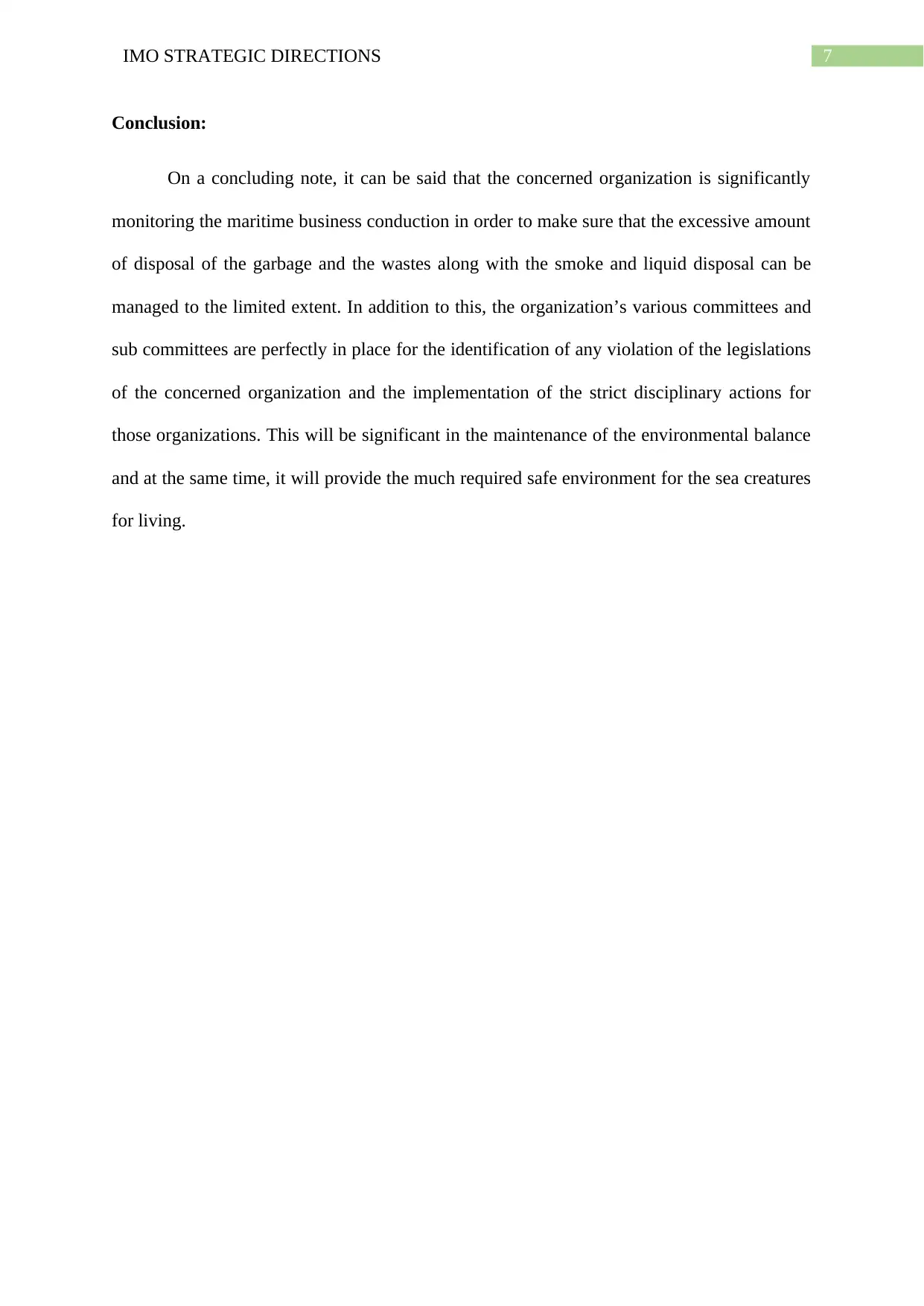
7IMO STRATEGIC DIRECTIONS
Conclusion:
On a concluding note, it can be said that the concerned organization is significantly
monitoring the maritime business conduction in order to make sure that the excessive amount
of disposal of the garbage and the wastes along with the smoke and liquid disposal can be
managed to the limited extent. In addition to this, the organization’s various committees and
sub committees are perfectly in place for the identification of any violation of the legislations
of the concerned organization and the implementation of the strict disciplinary actions for
those organizations. This will be significant in the maintenance of the environmental balance
and at the same time, it will provide the much required safe environment for the sea creatures
for living.
Conclusion:
On a concluding note, it can be said that the concerned organization is significantly
monitoring the maritime business conduction in order to make sure that the excessive amount
of disposal of the garbage and the wastes along with the smoke and liquid disposal can be
managed to the limited extent. In addition to this, the organization’s various committees and
sub committees are perfectly in place for the identification of any violation of the legislations
of the concerned organization and the implementation of the strict disciplinary actions for
those organizations. This will be significant in the maintenance of the environmental balance
and at the same time, it will provide the much required safe environment for the sea creatures
for living.
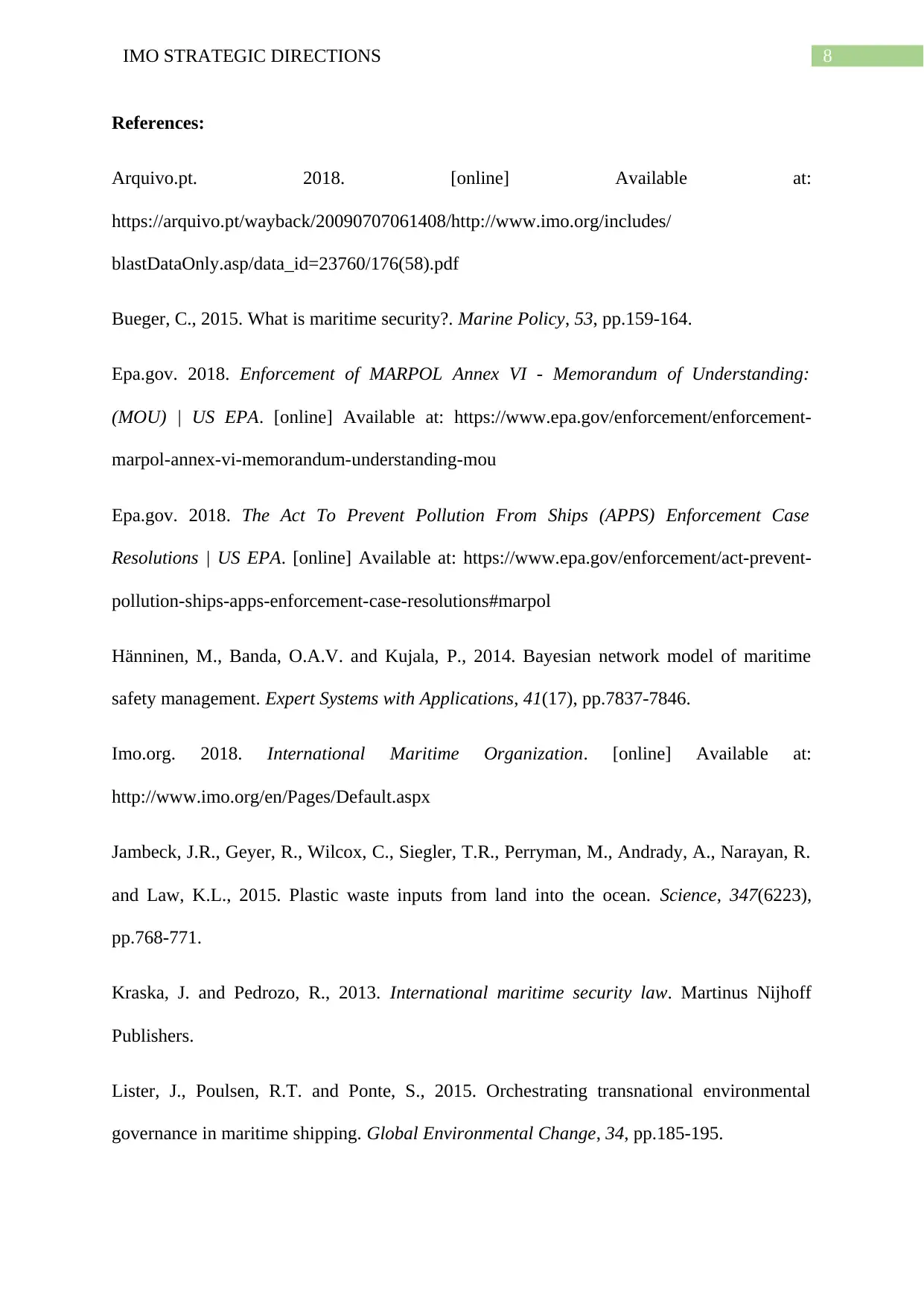
8IMO STRATEGIC DIRECTIONS
References:
Arquivo.pt. 2018. [online] Available at:
https://arquivo.pt/wayback/20090707061408/http://www.imo.org/includes/
blastDataOnly.asp/data_id=23760/176(58).pdf
Bueger, C., 2015. What is maritime security?. Marine Policy, 53, pp.159-164.
Epa.gov. 2018. Enforcement of MARPOL Annex VI - Memorandum of Understanding:
(MOU) | US EPA. [online] Available at: https://www.epa.gov/enforcement/enforcement-
marpol-annex-vi-memorandum-understanding-mou
Epa.gov. 2018. The Act To Prevent Pollution From Ships (APPS) Enforcement Case
Resolutions | US EPA. [online] Available at: https://www.epa.gov/enforcement/act-prevent-
pollution-ships-apps-enforcement-case-resolutions#marpol
Hänninen, M., Banda, O.A.V. and Kujala, P., 2014. Bayesian network model of maritime
safety management. Expert Systems with Applications, 41(17), pp.7837-7846.
Imo.org. 2018. International Maritime Organization. [online] Available at:
http://www.imo.org/en/Pages/Default.aspx
Jambeck, J.R., Geyer, R., Wilcox, C., Siegler, T.R., Perryman, M., Andrady, A., Narayan, R.
and Law, K.L., 2015. Plastic waste inputs from land into the ocean. Science, 347(6223),
pp.768-771.
Kraska, J. and Pedrozo, R., 2013. International maritime security law. Martinus Nijhoff
Publishers.
Lister, J., Poulsen, R.T. and Ponte, S., 2015. Orchestrating transnational environmental
governance in maritime shipping. Global Environmental Change, 34, pp.185-195.
References:
Arquivo.pt. 2018. [online] Available at:
https://arquivo.pt/wayback/20090707061408/http://www.imo.org/includes/
blastDataOnly.asp/data_id=23760/176(58).pdf
Bueger, C., 2015. What is maritime security?. Marine Policy, 53, pp.159-164.
Epa.gov. 2018. Enforcement of MARPOL Annex VI - Memorandum of Understanding:
(MOU) | US EPA. [online] Available at: https://www.epa.gov/enforcement/enforcement-
marpol-annex-vi-memorandum-understanding-mou
Epa.gov. 2018. The Act To Prevent Pollution From Ships (APPS) Enforcement Case
Resolutions | US EPA. [online] Available at: https://www.epa.gov/enforcement/act-prevent-
pollution-ships-apps-enforcement-case-resolutions#marpol
Hänninen, M., Banda, O.A.V. and Kujala, P., 2014. Bayesian network model of maritime
safety management. Expert Systems with Applications, 41(17), pp.7837-7846.
Imo.org. 2018. International Maritime Organization. [online] Available at:
http://www.imo.org/en/Pages/Default.aspx
Jambeck, J.R., Geyer, R., Wilcox, C., Siegler, T.R., Perryman, M., Andrady, A., Narayan, R.
and Law, K.L., 2015. Plastic waste inputs from land into the ocean. Science, 347(6223),
pp.768-771.
Kraska, J. and Pedrozo, R., 2013. International maritime security law. Martinus Nijhoff
Publishers.
Lister, J., Poulsen, R.T. and Ponte, S., 2015. Orchestrating transnational environmental
governance in maritime shipping. Global Environmental Change, 34, pp.185-195.
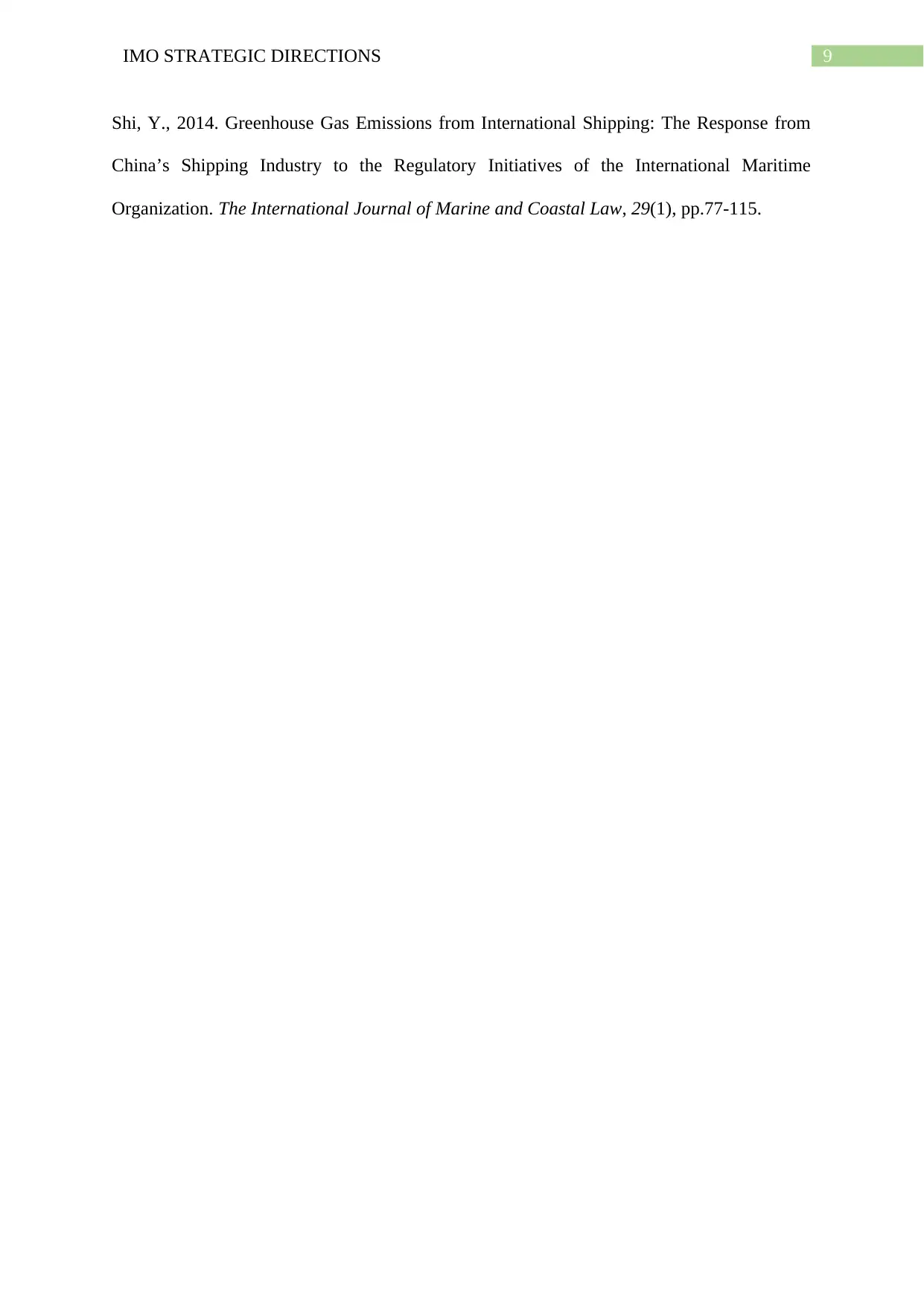
9IMO STRATEGIC DIRECTIONS
Shi, Y., 2014. Greenhouse Gas Emissions from International Shipping: The Response from
China’s Shipping Industry to the Regulatory Initiatives of the International Maritime
Organization. The International Journal of Marine and Coastal Law, 29(1), pp.77-115.
Shi, Y., 2014. Greenhouse Gas Emissions from International Shipping: The Response from
China’s Shipping Industry to the Regulatory Initiatives of the International Maritime
Organization. The International Journal of Marine and Coastal Law, 29(1), pp.77-115.
1 out of 10
Related Documents
Your All-in-One AI-Powered Toolkit for Academic Success.
+13062052269
info@desklib.com
Available 24*7 on WhatsApp / Email
![[object Object]](/_next/static/media/star-bottom.7253800d.svg)
Unlock your academic potential
© 2024 | Zucol Services PVT LTD | All rights reserved.





